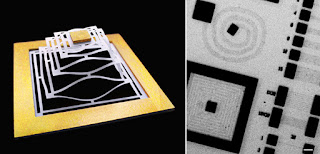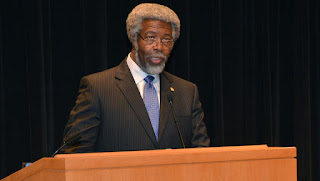Topics: Black Holes, CERN, God Particle, Heisenberg Uncertainty Principle, Humor, Large Hadron Collider, Particle Physics
Realize that the site Addicting Info usually titles its post with bombastic themes for equally outrageous stories. My response to this one regarding the latest conspiracy provocateur to enjoin that the Large Hadron Collider will "open other dimensions" or in a new twist, it's the "new Tower of Babel," and that its operation is a "dark and terrible chapter in human history." I posted the above meme sentiment and the following statement:
The "dark and terrible" chapter in human history is the willful choice of scientific ignorance in the 21st Century.
That got a lot of responses on Facebook, hundreds mostly positive with the exception of two trolls: one that ranted and the other that chimed in. They had their say and were brief and silent after that for the most part. The only dark and terrible time I can think of is the dark ages.
Willful meaning that with our access to the Internet and before that a public library, this kind of bombast without qualification is rather inexcusable. The only motivation is to pull a certain section of society towards your worldview; the only strength of your position is their ignorance, which unlike Thomas Gray's Ode on a Distant Prospect at Eton College, is not "bliss" or necessity: it is control.
A brief history of accelerators and particle physics:
Accelerators: John D. Cockcroft and Ernest Walton at the Cavendish Laboratory in Cambridge, England, sought a way into the nucleus through a prediction of quantum mechanics. George Gamow had suggested that a particle with too little energy to overcome the electrical repulsion of the nucleus through the barrier. (The trick was that the energy of the particle was not actually well-defined, according to Heisenberg's Uncertainty Principle). In 1930 Cockcroft and Walton used a 200-kilovolt transformer to accelerate protons down a straight discharge tube, but they concluded that Gamow's tunnelling did not work and decided to seek higher energies. [1] The Bubble Accelerator was designed by Donald A. Glaser, a popular apocryphal story about him contemplating the design over beer: it's something you hear as an undergrad and never, ever forget! He did win the Nobel Prize in 1960 for the Bubble Chamber.
Some examples:
Van der Graaf generator: If your high school physics teacher had you touch it and your hair stood on end like an Afro, THAT was a particle accelerator, no dimensions were opened or damaged in these experiments.
X-rays and nMRI: Nuclear Magnetic Resonance Imaging comes to mind. If you've had these procedures in a medical event, you have particle physics to thank for it.
Related info:
Black Holes: The byproduct of Red Giant stars that collapse after their nuclear fuel is spent at the end of their lifetimes. Our own sun at its end will likely become a Brown or White Dwarf, as it's not that massive. A large part of the analysis to even propose Black Holes was developed during the Second World War in the development of the atomic bomb. It was once so extreme, not even Einstein believed they could exist, though General Relativity pretty much predicted it. [2, 3]
CERN: European Organization for Nuclear Research. Here's a link that is a PDF on technological spin offs, some of which are things like, I don't know: the World Wide Web. The rants I've seen on web sites (or, even responses to some of my posts in the past) are breathtaking in their hypocrisy. I'd have more respect for a group that sincerely went back to snail mail, the Abacus and Slide Rule (I have the latter). There's even spin offs for treating cancer and solar panels.
The God Particle: Also known as the Higgs Boson. It was coined by Nobel Prize winning physicist Leon M. Lederman and science writer Dick Teresi in a book by the same name, the subtitle an obvious nod to "Hitchhiker's Guide to the Galaxy": The God Particle: If the Universe is the Answer, What Is the Question? Lederman often joked due to the frustration at the time not having found it - with a colorful metaphor what else he would like to have called it. In this case, 42 didn't quite cover it.
Particle Physics: "Particle physics is the branch of physics that studies the nature of the particles that constitute matter (particles with mass) and radiation (massless particles). Although the word "particle" can refer to various types of very small objects (e.g. protons, gas particles, or even household dust), "particle physics" usually investigates the irreducibly smallest detectable particles and the irreducibly fundamental force fields necessary to explain them. By our current understanding, these elementary particles are excitations of the quantum fields that also govern their interactions. The currently dominant theory explaining these fundamental particles and fields, along with their dynamics, is called the Standard Model. Thus, modern particle physics generally investigates the Standard Model and its various possible extensions, e.g to the newest "known" particle, the Higgs boson, or even to the oldest known force field, gravity." Wikipedia
Wormholes: See Kip Thorne's book below [2]. It was the Einstein-Rosen Bridge seen in the movies Contact from Carl Sagan's novel and most recently, Marvel's Thor. An advanced civilization that lived beyond its technological adolescence (i.e., they didn't blow themselves to kingdom come) could probably engineer one.
So, rather than a soundbite, I thought it important to give longer explanations. It's easier to find out How Accelerators Work [4] by simply going to a site where experts give an explanation for consumption by the general public.
As a country, we have a historic fear and loathing of science - the aforementioned bomb [3] and the Tuskegee Experiments didn't help. This "dark and terrible chapter" for the most part had a lot of positive spin offs that have benefited everyone. Now, ignorance is a choice, but not a permanent state of affairs. As Carl Sagan said, "We live in a society exquisitely dependent on science and technology, in which hardly anyone knows anything about science and technology." That state can be remedied.
1. American Institute of Physics: Early Particle Accelerators
2. "Black Holes and Time Warps-Einstein's Outrageous Legacy," Kip Thorne
3. #P4TC: M.A.D...
4. CERN: How Accelerators Work













